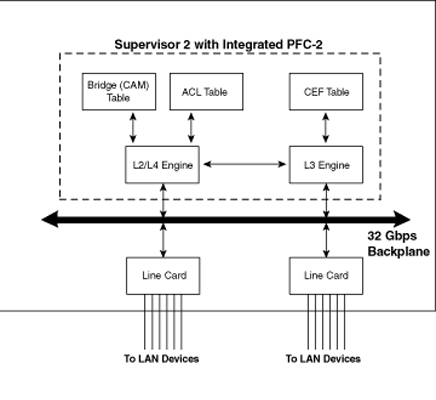Supervisor 2 (SUP2) with PFC-2
The first configuration available for the Catalyst 6000/6500 with a Supervisor 2 module is the Supervisor 2 with a policy feature card 2 (PFC-2) installed (the Supervisor 2 is integrated with PFC-2; you can't purchase either separately). The PFC-2 is similar in function to the PFC-1, enabling Layer 3 classification for QoS classification and security ACL filtering; however, it is twice as fast as the PFC-1 and supports more ACLs that can be stored in hardware for QoS and Security. The Supervisor 2 with PFC-2 is capable of switching packets and performing Layer 3/4 QoS classification and ACL filtering at up to 30 Mpps; however, this requires switch fabric enabled modules and a switch fabric module to be installed. Because no MSFC is present in this configuration, L3 switching is not possible.
Let us take a look at the architecture of SUP2 with PFC-2
The most
notable difference as compared to SUP 1A with PFC-1 is that the Layer 2 and ACL engine are now combined into a
single L2/L4 engine, which boosts the performance capabilities of L2 switching
combined with Layer 3/4 QoS classification and ACL filtering up to 30 Mpps. The
L3 engine is not used for L3 switching, because an MSFC-2 (route processor) is
required to generate information contained in the CEF table.
Supervisor 2 (SUP2) with PFC-2 and MSFC-2
To enable Layer 3 switching on a Supervisor 2 with PFC-2, the only option is to add an MSFC-2.
NOTE : MSFC-1 is not supported with SUP2.
To enable Layer 3 switching on a Supervisor 2 with PFC-2, the only option is to add an MSFC-2 (the MSFC-1 is not supported on the Supervisor 2). In this architecture, the L3 engine onboard the PFC-2 can perform L3 switching, because a route processor is now present in the form of the MSFC-2. Figure 6-6 shows the architecture of the Supervisor 2 with PFC-2 and MSFC-2.
In Figure 6-6, the addition of the MSFC allows for the L3 engine to L3 switch
inter-VLAN traffic. All other features of the PFC, such as QoS classification
and ACL filtering, are also supported. The PFC-2 and MSFC-2 use CEF to perform
L3 switching; the MSFC-2 is responsible for generating the appropriate CEF
tables.
Advantage of SUP2 over SUP 1A :
1. In case of SUP2 as soon as packets need to be L3 switched, the L3 engine has the necessary information to L3 switch the packet, without having to send the first packet associated with a flow to the MSFC.
2. This architecture eliminates the issue that MLS has for supporting an environment that has thousands of connections being established every second.
The Supervisor 2 with PFC-2 and MSFC-2 can L3 switch packets at 30 million packets per second.
The first configuration available for the Catalyst 6000/6500 with a Supervisor 2 module is the Supervisor 2 with a policy feature card 2 (PFC-2) installed (the Supervisor 2 is integrated with PFC-2; you can't purchase either separately). The PFC-2 is similar in function to the PFC-1, enabling Layer 3 classification for QoS classification and security ACL filtering; however, it is twice as fast as the PFC-1 and supports more ACLs that can be stored in hardware for QoS and Security. The Supervisor 2 with PFC-2 is capable of switching packets and performing Layer 3/4 QoS classification and ACL filtering at up to 30 Mpps; however, this requires switch fabric enabled modules and a switch fabric module to be installed. Because no MSFC is present in this configuration, L3 switching is not possible.
Let us take a look at the architecture of SUP2 with PFC-2
 |
| Fig 31.3.1 |
Supervisor 2 (SUP2) with PFC-2 and MSFC-2
To enable Layer 3 switching on a Supervisor 2 with PFC-2, the only option is to add an MSFC-2.
NOTE : MSFC-1 is not supported with SUP2.
To enable Layer 3 switching on a Supervisor 2 with PFC-2, the only option is to add an MSFC-2 (the MSFC-1 is not supported on the Supervisor 2). In this architecture, the L3 engine onboard the PFC-2 can perform L3 switching, because a route processor is now present in the form of the MSFC-2. Figure 6-6 shows the architecture of the Supervisor 2 with PFC-2 and MSFC-2.
 |
| Fig 31.3.2 |
Advantage of SUP2 over SUP 1A :
1. In case of SUP2 as soon as packets need to be L3 switched, the L3 engine has the necessary information to L3 switch the packet, without having to send the first packet associated with a flow to the MSFC.
2. This architecture eliminates the issue that MLS has for supporting an environment that has thousands of connections being established every second.
The Supervisor 2 with PFC-2 and MSFC-2 can L3 switch packets at 30 million packets per second.
No comments:
Post a Comment